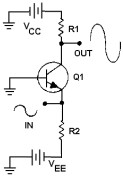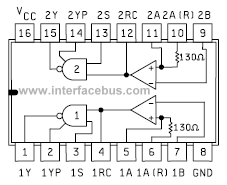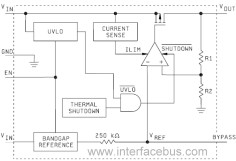Dictionary of Electronics Terms
"A"
"B"
"C",
"D",
"E",
"F",
"G",
"H",
"I",
"J",
"K",
"L",
"M",
"N",
"O",
"P",
"Q",
"R",
"S",
"T",
"U",
"V",
"W",
"X",
"Y",
"Z"
'La' to 'Ld', 'Le' to 'Lil', 'Lim' to 'Ln', 'Lo' to 'Log', 'Log' to 'Lz',
Limiter. A device that prevents (limits) a waveform from exceeding a specified value. A device in which the voltage or some other characteristic of the output signal is automatically prevented from exceeding a specified value. |  Diode Limiter |
Limiter Circuit: A circuit of nonlinear elements that restricts the electrical excursion of a variable in accordance with specified criteria. A circuit that removes or clips all or part of either the positive or negative portion of an input wave. Also called a clipper circuit when a diode is used to limit or clip the voltage range. A limiter circuit might use a series element, a shunt element or add a voltage bias to shift the output further. A stage in an FM demodulator system designed to limit the signal to a certain amplitude.
Line. A physical medium for transferring electrical or electromagnetic energy from one point to another for purposes of communications.
Linear. Having an output that varies in direct proportion to the input.
Linear Amplifier. An amplifier with an amplified output that follows and replicates the input. An amplifier that reproduces an exact copy of the input signal, except with an increase in amplitude [based on the gain of the amplifier]. A Class A amplifier.
Linear Impedance. An impedance in which a change in current through a device changes in direct
proportion to the voltage applied to the device.
Linear Regulator. A regulator that outputs a fixed voltage regardless of the current drawn and performs this function based on a linear difference between the output and the input; not a switching regulator.
Linearity. A change in the input which produces a directly proportional change in an output. A change in the value of one quantity is directly proportional [linearly] to a change in the value of another quantity
Line Balance. The degree of electrical similarity of the two conductors of a transmission line.
Line Codes. The codes used when converting a bit stream for data transmission over a communication line. Example line codes include unipolar binary signaling [0 to + DC], Polar [-DC to +DC], or AMI for Alternate Mark Inversion [bipolar] to name just a few possible line code.
Line Cord. A Power cord. A cable assembly used to transfer voltage from one system to another, normally using defined connectors on both ends. Also refer to the listing of Manufacturers of Line Cords, which also lists power cord specifications.
Line Driver. An amplifier used to enhance the transmission reliability of a usually digital metallic transmission line, over extended distances [with-in a facility], by driving the input to the transmission line with a higher than normal signal level. A logic buffer that has a higher than normal drive capacity as in a 74244 Buffer, or 74541 logic buffer.
Line-Fault. An open line or a line shorted to another line or some non-circuit element.
Line-Lose. A mount of energy lost in a transmission line.
Line-Man Splice. A joint formed by the connecting of two or more conductors. The Lineman splice is one of a number of different styles of wire splices.

Lineman Wire Splice
Line of Force. A line in an electric or magnetic field that shows the direction of the force.
Line-Pulsing Modulator. Circuit that stores energy and forms pulses in the same circuit element,
usually the pulse-forming network (pfn).
Line Receiver. A circuit or IC used to receive signals over a long line. Normally a line receiver is a linear device, as any digital IC could be considered a line receiver because it would receive and re-shape the signal [if the logic threshold was achieved].
Line Regulation. The change in output voltage for a change in the input voltage of a circuit.
Line Voltage. The AC voltage present on an electrical outlet, 120 volts AC for normal outlets, or 240 volts AC for heavy duty outlets [both at 60Hz, U.S.].
Link. The communications facilities between adjacent nodes of a network. Also refer to a listing of Different Network Topologies.
Link Protocol. A set of rules relating to data communications over a data link. Also refer to a listing of Different Network Protocols.
LIN-LOG Amplifier. An amplifier in which the response is linear for weak signals and logarithmic for
large signals.
Liquid-Cooling System. Source of cooling for high-heat producing equipments, such as
microwave components, radar repeaters, and transmitters.
Liquid Crystal Display. [LCD] A display device that creates characters by means of the action of electrical signals on a matrix of liquid cells that become opaque when energized. Related listing of Liquid Crystal Display Manufacturers.
Lissajous Pattern. A combined, simultaneous display of the frequency and phase relationships of two input signals on a CRT or display of an oscilloscope. One signal is applied to the vertical amplifiers and the other signal is applied to the horizontal amplifiers of the oscilloscope. |  Lissajous Pattern |
Lithium-Ion Battery. A Battery that uses lithium metallic oxide in its positive electrode (cathode) and carbon material in its negative electrode (anode). More data on Lithium Batteries.
Little-Endian. A byte-ordering method in memory where the address n of a word corresponds to the least significant byte. In an addressed memory word, the bytes are ordered from 3, 2, 1, 0, with 3 being the most significant byte [MSB].











